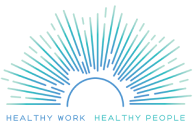Healthy Work Tools
For Employers
What can we do now?
If your organization used the Healthy Work Survey to find out if you have (un)healthy work at your workplace, you’re probably asking what you can do about the results (beyond what the survey recommends).
Below you will find recommendations, tools and strategies from experts in the field of work stress to help you take action to address the work stressors that threaten the health and well-being of employees and make your organization less productive.

Not one set of recommendations fits all. Healthy work can be achieved by improving the quality of jobs and by reducing specific work stressors. Which work stressors—and how to best accomplish this—will depend on your industry, the size of your company, and your existing resources and infrastructure.
Remember, these tools and strategies are meant to complement your own organizational resources, which may already include:
- A commitment to improve organizational culture and the health and safety of workers.
- Implementation of wellness programs, employee assistance programs, or assessments of employee/organizational health and productivity.
What can our organization do to combat work stress?
Step One – Review and share your organization’s Survey Report and LEARN what exposure to particular work stressors may mean to your employees and organization, using the Principles of Healthy Work.
Step Two – Is your organization ready for healthy work? Find out what unhealthy work is costing your organization.
Step Three – Some general ideas for how to reduce work stressors and a series of reports – Healthy Work Strategies – summarizing workplace research projects, programs/policies, as well as current or pending laws and regulations intended to promote healthy work.
Step Four – Plan and design your own “healthy work programs/policies” with participation at all levels of your organization (especially employees).

Want to know more? Read on.
STEP ONE:
Review the findings from your survey report and LEARN about how the work stressors common in your organization can be reduced or improved to make healthier work and healthier workers. Share your ideas and thoughts with key members of your organization. If you have questions about your report, you can Get Feedback.
STEP TWO:
Is your organization ready for healthy work? Find out what unhealthy work is costing your organization.
- Read our case for why it benefits organizations to reduce work stressors and improve job quality: Business Costs of Unhealthy Work.
- Need more help convincing leadership about prioritizing the health and safety of workers? Or to find out how your current employee wellness or health and safety resources might work more effectively?
- Check out the NIOSH Total Worker Health® program to enhance your policies and practices around workplace health and safety. The Total Worker Health (TWH) approach includes strategies that recognize that working conditions are important factors that can lead to illness and injury, and that job-related factors such as wages, hours of work, workload, coworker and supervisor support, access to paid leave, and health-promoting workplaces all can have an impact on the well-being of workers, their families, and their communities. Implementing TWH policies, programs, and practices in your organization can be a good starting point in promoting #healthywork. Also take a look at the TWH “Business Case” and this checklist if you want to implement the TWH approach in your organization.
STEP THREE:
First, we have provided some General Ideas for reducing specific work stressors such as:
Long work hours, bullying, sexual harassment, discrimination, threats of violence, understaffing, job insecurity, lack of supervisor or coworker support, work-family conflict, job demands, lack of job control, job strain, and “effort-reward imbalance.”
Second, we have provided a series of reports summarizing various ways to improve the organization of work to reduce work stressors. These Healthy Work Strategies include workplace policies, programs, regulations and laws designed to reduce sources of stress at work (work stressors), and to make work and workers healthier.
GENERAL IDEAS TO REDUCE WORK STRESS
Enhance job control; reduce demands/efforts. **
- Develop standards for job descriptions so that there are reasonable workloads, a variety of tasks, clear responsibilities, as well as a clear line of reporting.
- Establish policies and train managers to encourage employee participation in decision-making and encourage employees ability to carry out their tasks with more independence and autonomy.
- Evaluate manager performance in the following areas:
- Involving all employees in discussing problems and solutions,
- Communicating frequently with employees about important decisions and future plans,
- Arranging work assignments to prevent excessive demands,
- Planning work carefully with employees to agree on achievable deadlines or work pace,
- Ensuring that tasks and responsibilities are clearly defined, and
- Providing employees with opportunities for learning and skills development.
** Adapted from the Job Stress Intervention Guide, TWH Center for Promotion of Health in the New England Workplace, 2015
Create a more supportive work environment. **
- Organize job roles to allow employees to participate in work teams.
- Train managers/supervisors on effective leadership of work teams and effective communication.
- Form labor-management committees (where they don’t already exist) to allow effective feedback from employees and management on all issues pertaining to worker health, safety, and work stress.
- Sponsor social events to foster teamwork and positive relationships.
- Make sure that meal break areas are clean, furnished, and well-equipped, so employees can socialize at break times.
- Organize peer support groups (such as healthy lifestyle, elder caregivers, illness/injury prevention) for employees in the workplace and help employees to connect with support groups in the community.
** Adapted from the Job Stress Intervention Guide, TWH Center for Promotion of Health in the New England Workplace, 2015
Address work-life balance. **
- Adopt policies on fair and flexible work schedules appropriate to the industry; communicate policies and procedures to all employees.
- Establish firm limits to avoid excessively long work hours.
- Train supervisors how to communicate and support existing work-life policies and programs.
- Expand benefits and programs to assist with managing personal and caregiving needs, including workplace breastfeeding support.
- Develop vacation or sick leave pool programs to help employees during hardship.
** Adapted from the Job Stress Intervention Guide, TWH Center for Promotion of Health in the New England Workplace, 2015
Reduce incivility, promote justice & fairness. **
- Incivility includes bullying, hostile workplaces, sexual harassment and discrimination.
- Be familiar with the U.S. Equal Employment Opportunity Commission (EEOC) and with laws & guidance on workplace sexual harassment and Laws & guidance on employment discrimination.
- Establish policies and procedures to deal with incivility, abuse, harassment, and violence at work.
- Use precise definitions in policies for workplace bullying, sexual harassment and discrimination, and include proactive steps that address the bully/perpetrator—not the target.
- Incorporate respect and fairness into the company mission statement, personnel policies, and expectations for daily interactions.
- Provide training for all employees on respectful and fair treatment in the workplace; involve executives, managers, supervisors, production employees, and all new hires.
- Reward employees for being good role models for respect and fairness in the workplace.
** Adapted from the Job Stress Intervention Guide, TWH Center for Promotion of Health in the New England Workplace, 2015
Address job security and precarious jobs. **
- When possible, extend the same pay and benefits to non-standard employees that are offered to similar status permanent employees.
- Include all non-standard employees in workplace health and safety training programs, wellness programs and employee assistance programs.
- Prior to implementing restructuring, consider:**
- Evaluating the economic and social impact on workers, families and communities, and the long-term impact on company innovation and sustainability.
- Early communication with employees, their representatives, and other local stakeholders (e.g. communities, local authorities).
- Instituting employee skill development and job retraining or cross-training.
- Alternatives to layoffs including temporary or long-term working-time reductions, re-negotiation of working conditions.
- Help with job-search, including paid time off to search for jobs.
**Adapted from the European Parliament adopted report to The Commission on Information and Consultation of Workers, Anticipation and Management of Restructuring, 2012.
Address hours, shifts and schedules.
- Be aware of laws governing work hours: US Department of Labor – The Fair Labor Standards Act (FLSA); Federal Motor Carrier Safety Administration.
- Establish firm limits to avoid excessively long work hours.
- When possible, avoid “on-call scheduling” and give an employee reasonable advance notice of their schedule.
- Recognize the dangers (and productivity costs) of disrupted sleep and fatigue due to shift work and long work hours, and consider redesigning the work schedule, redistributing the workload, or offering longer recovery times.
- Avoid frequent rotations between night and day shifts when possible.
- Offer shift workers educational programs and resources to improve sleep strategies, exercise and diet programs, and relaxation techniques.
Provide fair pay/living wages/benefits.
- Pay all low-wage workers at least a “living wage.” (See the MIT living wage calculator based on your region’s cost of living.)
- Consider implementing a “parity policy” for subcontracted or temporary workers.
- Expand benefits and programs to assist with managing personal and caregiving needs.
- Develop vacation or sick leave pool programs to help employees during hardship.
HEALTHY WORK STRATEGIES
Workplace research studies and programs to reduce work stressors
These workplace research studies and programs, published in scientific journals, were selected because they were designed to reduce sources of stress at different workplaces in order to improve employee health (health promotion programs intended to change individual behaviors are not included). Many include a participatory “action” research focus, which means they involved workers, labor and management in a process that was intended to create positive change. These studies document the effects of workplace programs and policies and provide important details about the process of changing working conditions—so that you can see if such a process might work in your workplace or industry.
Health Care
Reducing work stress and improving the mental health of hospital workers (Quebec, Canada)
Manufacturing
Job redesign at a sweets manufacturing company in England
Public Sector Workers
Increasing job control and reducing other job stressors among call center workers in England
Redesigning the jobs of postal workers in Uppsala, Sweden
Supervisor Support and Work-life balance
Teachers/Education
Workplace policies and programs to reduce job stress among K-12 education staff (U.S.)
Transit Workers – bus drivers
Action research intervention with urban bus drivers in Copenhagen, Denmark
Bathroom access for bus drivers in the US and Canada
Intervention to reduce job stress among urban bus drivers in Stockholm, Sweden
Preventing threats and violence against bus drivers
Programs and policies to reduce work stress among bus drivers in the United States and Canada
Workplace bullying/discrimination/violence
A training program for workers and managers on reducing male bullying and workplace violence (U.S.)
If you are interested in learning about reducing COVID-19-related work stressors, visit our Healthy Work Strategies page for more info.
Laws and Regulations
While many of these legislative efforts to improve working conditions and promote healthy work have not been scientifically studied to determine their effectiveness, they are legal requirements and thus don’t depend upon the level of cooperation of a particular manager or supervisor. Laws and regulations also typically reach more people than the workplace-based programs that have been studied. These short reports were based on news stories and reports from specific organizations and/or industry publications.
Government labor inspectors’ role in protecting workers’ mental health in Québec
Job redesign and national labor protections have positive effects on worker health and the economy
Laws and regulation to prevent workplace violence in healthcare
Laws prohibiting mandatory overtime for nurses
Laws to improve nurse staffing levels in hospitals in the U.S.
Laws to prevent workplace sexual harassment
Legislation to prevent psychosocial risks in healthcare (E.U.)
Legislation to reduce job stress in education & healthcare (summary)
State laws banning mandatory overtime for nurses, except in case of emergency.
Stress Check: A national policy in Japan for prevention of workplace stress
Work scheduling laws contribute to more stable employment
Workplace bullying prevention laws and regulations
Healthy Families Act
This bill (currently in Congress) which would allow workers to earn up to seven paid sick days a year. Creating a national paid sick leave standard would allow millions of Americans to earn the time necessary to recover from illnesses like the flu, access health care, and take care of a sick family member.
STEP FOUR:
Plan and design your own “healthy work programs/policies” with participation at all levels of your organization (especially employees).
- Consult all stakeholders about what you found when your organization took the survey.
- Based on Step Three, introduce stakeholders to the evidence-based research, programs or strategies from other organizations that have successfully improved work stressors or promoted healthy work.
- Ask all stakeholders for feedback about feasible and sustainable ways to implement similar programs/policies that would reduce work stressors and promote healthy work in your organization.
How?
- Check out the Healthy Workplace Participatory Program (HWPP) developed by the Center for the Promotion of Health in New England (CPH NEW), a NIOSH Total Worker Health® Center of Excellence. As the next step for setting up a program to address work stressors, it must involve employees and all stakeholders in your organization committed to providing healthy work.
- It offers you specific guidance on
- How to conduct focus groups with employees/other stakeholders to get feedback about the survey findings.
- How to introduce work stress intervention ideas and programs. (See Step Three for examples.)
- How to create “design teams/committees” to review survey and focus group findings, discuss evidence-based programs to reduce work stress, and design/plan innovative healthy work interventions for your specific organization.
- Ways to implement and evaluate healthy work programs.
- How will this program benefit your organization?
The HWPP is scientifically “field-tested” and engages employees and all levels of management in addressing a wide range of work environment, work organization, safety, and employee health issues. It works for starting new programs or enhancing existing programs and includes tools and information that you can pair with the report you received from the survey.
More Resources
Selected organizations committed to promoting good, quality jobs or healthy workplaces**
B Corps
B Corps is a community and certification process for businesses who seek to redefine success in business and to build a more inclusive and sustainable economy. The B-Corp community works towards reducing inequality and poverty, building a healthier environment, stronger communities and the creation of high-quality jobs with dignity and purpose. Certified B-Corporations undergo a rigorous assessment of the company’s impact on its workers, customers, community, and environment and are required to amend their legal governing documents to require their board of directors to balance profit and purpose. Check out the B-Corp Directory for companies that have been certified and may offer many of the elements of a healthy workplace.**
Family Values @ Work
Family Values @ Work is a national network of 27 state and local coalitions helping spur the growing movement for family-friendly workplace policies, such as paid sick days and family leave insurance, which will result in better individual and public health, and greater financial security for families, businesses and the nation. If you would like more information about the benefits of family-friendly work policies such as paid sick days and paid leave, check out these resources, toolkits, and employer examples.
The Good Jobs Institute
The Good Jobs Institute is a nonprofit that was established to help companies thrive by creating good jobs. The Institute offers tools and resources to executives who want to improve the jobs and lives of their employees in a way that improves the performance and competitiveness of their companies. The Good Jobs Strategy is a book authored by co-founder of the Good Jobs Institute, Zeynep Ton, a professor at the MIT Sloan School of Management. It is a system offered to businesses interested in providing good jobs by combining investment in employees with operational choices that increase employee productivity, contribution, and motivation.
Good Companies, Good Jobs Initiative
The Good Companies, Good Jobs Initiative is anchored within MIT Sloan’s Institute for Work and Employment Research (IWER). It strives to be a catalyst for ideas, a testing ground for new management models, and a hub where learning and business practice meet. The Initiative strives to answer the questions: What is good work? What are good jobs? What is a good company? What factors encourage or hinder the creation of high-quality jobs?
International Labor Organization (ILO)
The International Labour Organization (ILO), a U.N. agency since 1919, brings together governments, employers and workers from 187 member states, to set labor standards, develop policies and devise programs promoting decent work for all women and men.
Stress Prevention at Work Checkpoints is an app and a manual designed for use by anyone interested in workplace stress prevention: national authorities, company and organizational managers, trade unions, human resource personnel, and occupational safety and health practitioners. The ILO SOLVE program is also available to download. It is an interactive educational program designed to assist in the development of policy and action to address health promotion issues at the workplace. It deals with the prevention of work-related stressors (both workplace stress and economic stressors), alcohol and drug abuse, violence (both physical and psychological), the prevention of HIV/AIDS, as well as the promotion of tobacco-free workplaces and health lifestyles, including good eating, sleeping and exercise habits. It includes guides for trainers and participants.
In January 2019, the ILO’s Global Commission on the Future of Work released the report, “A Human-Centered Agenda Needed for a Decent Future of Work.”
Among the ten recommendations are:
- A universal labour guarantee that protects fundamental workers’ rights, an adequate living wage, limits on hours of work and safe and healthy workplaces.
- Guaranteed social protection from birth to old age that supports people’s needs over the life cycle.
- A universal entitlement to lifelong learning that enables people to skill, reskill and upskill.
- Managing technological change to boost decent work, including an international governance system for digital labour platforms.
- Greater investments in the care, green and rural economies.
- A transformative and measurable agenda for gender equality.
- Reshaping business incentives to encourage long-term investments.
The Interdisciplinary Center for Healthy Workplaces
The ICHW at UC Berkeley has a mission to reinvent workplaces by applying interdisciplinary sciences to achieve worker health and psychological well-being. ICHW has built relationships with researchers, practitioners, policymakers, service providers and corporate representatives to learn about the ways health and well-being are addressed and the barriers to achieving greater progress. ICHW’s interdisciplinary team reviews and evaluates the effectiveness of interventions, programs and practices.
National Institutes of Occupational Safety and Health
NIOSH resources on sleep, fatigue, shift-work and long hours: A significant number of U.S. workers are exposed to health and safety risks associated with shift work, long work hours, and related workplace sleep and fatigue issues. If you are an organization in the aviation, transportation, or healthcare industries, or are in emergency services, or have found employees in your organization are working long hours and night shifts, this can be particularly dangerous to the health and well-being of your employees and organization—and potentially the public. NIOSH has made available a webinar series and other resources about how shift work and long hours affect fatigue and sleep, as well as trainings and resources for coping and minimizing the effect of shift work and long hours.
NIOSH resources on Non Standard Work Arrangements include workers considered temporary help, contingent, part-time, on-call, direct hire, agency, contract, app-based, on-demand, freelance, and gig workers. Independent contractors do not have a legal right to a safe workplace and are not legally eligible for workers’ compensation benefits if they are injured on the job. Many non-standard, low-wage workers do not earn minimum wage. Studies have shown that non-standard workers are more likely to get injured on the job and are more likely to become ill compared to permanent workers which may be related to a lack of paid sick leave. OSHA and NIOSH have developed a joint guideline for employers of temporary workers (e.g. staffing agencies): Recommended Practices for Protecting Temporary Workers and Cal OSHA has also produced a Safety and Health Fact Sheet on this issue.
NIOSH Total Worker Health Centers of Excellence
The National Institute for Occupational Safety and Health funds six Centers of Excellence (COE) to conduct research on Total Worker Health (TWH) approaches. The COEs advance knowledge to improve the overall safety, health, and well-being of the diverse population of workers in our nation. The COEs use multidisciplinary research projects, including intervention-focused research, outreach and education, and evaluation activities to improve our understanding of which solutions work. Check out the Essential Elements of Effective Workplace Programs and Policies for Improving Worker Health and Wellbeing, which is a guide for employers and employee-employer partnerships that identifies 20 components of a comprehensive work-based safety and health program, and includes both guiding principles and practical direction for organizations seeking to develop effective workplace health programs.
NIOSH also provides a Stress at Work guide that provides a comprehensive approach to preventing job stress, including resources and steps that organizations can take.
Oregon Healthy Workforce Center
The Oregon Healthy Workforce Center (OHWC) offers four scientifically validated Total Worker Health® toolkits through YourWorkpath.com. These four toolkits are available online and are intended to improve workplace safety, health, and well-being by improving social support, supervisor practices, safety practices and healthy lifestyles. The Safety and Health Improvement (SHIP) toolkit improves safety, health and well-being in the workplace by increasing supervisor support and team effectiveness in any industry. The BeSuper! toolkit helps supervisors and employees in construction industries improve supervisor communication and support, safety practices and healthy lifestyles. Community of Practice and Safety Support (COMPASS) is a program that creates a supportive community for home care workers to increase access to training, reduce the risk of injuries, and promote health through peer support. The PUSH toolkit – Promoting U through Safety and Health – is aimed at young workers to reduce workplace injuries, improve communication skills and increase healthy lifestyle behaviors.
Preventing Suicide: A Resource at Work (WHO)
The World Health Organization (WHO) offers this guide to addressing the organizational and work-related psychosocial elements that can increase the risk of suicide among workers. It provides information for employers, managers, and colleagues about how they can promote workforce mental health. The WHO has estimated that one suicide occurs every minute. Suicide accounts for 8% of all working days lost due to death. Recent research shows that those exposed to work stressors such as job strain and effort-reward imbalance are twice as likely to think about committing suicide. (Loerbroks et al, Journal of Psychosomatic Research, 2016)
Responsible Restructuring
Responsible restructuring is an innovative, alternative set of strategies and recommendations for minimizing the impact of restructuring. A 2002 article published in the Academy of Management Perspectives points out that while organizations use employment downsizing to reduce operating costs and enhance their competitive positions in a global marketplace, there are serious doubts as to the long-term payoff of this approach. The article highlights several alternative approaches to restructuring, as well as company examples and research-based findings that illustrate mistakes to avoid and affirmative steps to take when intending to restructure responsibly. Given the known impact of restructuring on the health and well-being of downsized employees and their families and communities, a network of experts in Europe developed a website on responsible restructuring that included a number of projects funded by the European Commission. In 2013, the European parliament adopted a set of 14 recommendations in a plenary session, regarding corporate restructuring. In June 2019, the European Union issued a formal directive on responsible restructuring.
Restaurants Advancing Industry Standards in Employment
RAISE is an association of restaurant industry leaders committed to taking the “high road” to profitability. Through RAISE, restaurant owners learn about sustainable business models that champion living wages, basic benefits, fair promotion policies, among other “high road” employer practices as recipes for success, not impediments to profitability. Convened by Restaurant Opportunities Centers United (ROC United), the leading restaurant workers’ rights advocacy organization in the country, RAISE is including restaurant owners in the conversation.
U.S. Breastfeeding Committee
The U.S. Breastfeeding Committee is an independent non-profit organization that includes representatives from government, non-governmental organizations, and health professional associations, who advocate for policies and practices that support breastfeeding across the U.S. They offer resources for employers regarding the “Breaktime for Nursing Mothers” law and provide webinars for employers to understand their responsibilities in this important area of work-family balance. Also check out these resources from the Office on Women’s Health about Supporting Nursing Moms at Work.
U.S. Dept of Veterans Affairs - Civility, Respect and Engagement in the Workplace (CREW)
U.S. Dept of Veterans Affairs CREW is a culture-change initiative launched by the VHA National Center for Organizational Development after employee feedback that low levels of “civility” were affecting job satisfaction. More than 1,200 VA work groups have utilized this program to improve the work climate by encouraging more civil and respectful interactions. The results have been higher job satisfaction and intent to stay, reduced sick leave, fewer EEO complaints, and better patient care outcomes.
Work Family Health Network
The Work Family Health Network is an interdisciplinary team of researchers who have conducted research on work-life balance (and other issues) to improve the health and well-being of working people and benefit employers. These researchers found that workers supervised by family-supportive managers were significantly more likely to experience lower levels of work-family conflict, higher job satisfaction, lower intention to change jobs, and higher reports of physical and mental health. If your organization has high levels of work-life conflict, check out these important scientifically validated toolkits that could be used to help your organization find ways to reduce work-family conflict and increase productivity by decreasing unnecessary work and increasing everyone’s control over their time.
Workplace Bullying Institute
Workplace Bullying Institute (WBI) offers comprehensive resources about workplace bullying, including for organizations that want to address bullying in the workplace. WBI includes self-help advice for individuals, personal coaching, research, books, public education, union assistance, training for professionals, employer consulting, and legislative advocacy. In 2001, WBI launched the Healthy Workplace Bill, which has now been introduced in 31 states/territories. If you want to get involved in supporting this bill in your state, review your options.
**Note: Not all of the companies acknowledged by the organizations in this list will reflect all of the Principles of Healthy Work or be completely consistent with our Healthy Work Agenda.






